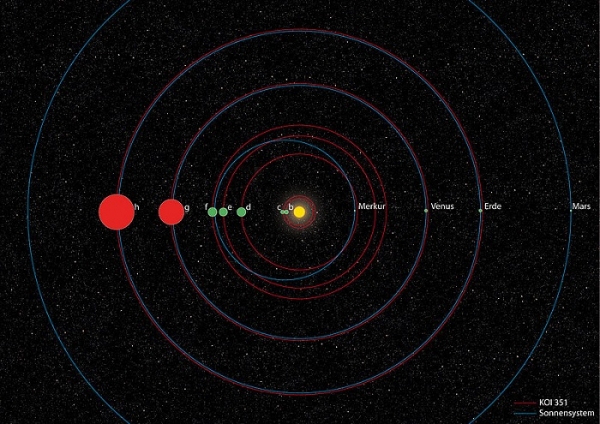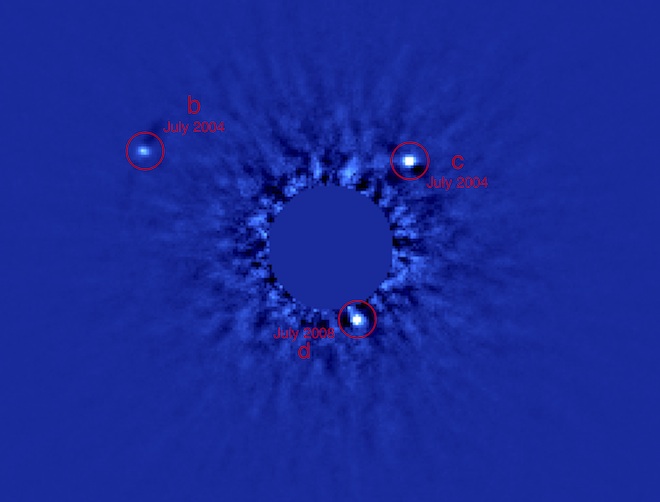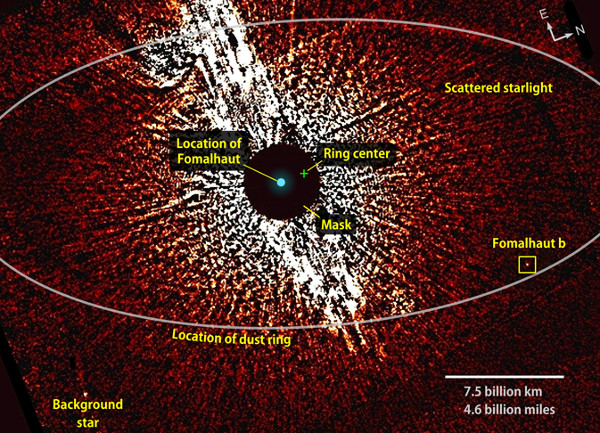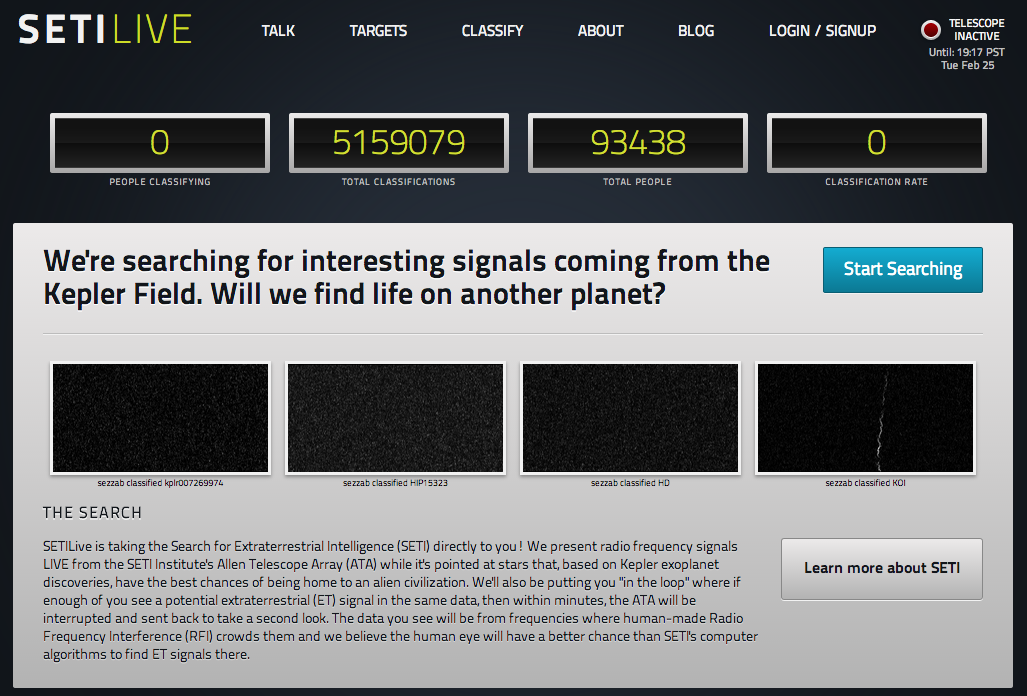It looks like you're using an Ad Blocker.
Please white-list or disable AboveTopSecret.com in your ad-blocking tool.
Thank you.
Some features of ATS will be disabled while you continue to use an ad-blocker.
19
share:

Seven of the 715 new planets recently discovered by NASA all orbit the star Kepler-90; the finding reveals the first-known seven planet system that crosses in front of its host star.
The discovery was made by University of Washington astronomer Eric Agol, a University of Washington news release reported. He also helped to confirm that the object being studies was a planetary system.
In the seven planet system two of the objects are believed to be Earth-sized. There are also believed to be three Super-Earths, which are "planets larger in mass than Earth but less than 10 times [or] so," the news release reported.
This sounded interesting. I thought I'd post it and see what everybody thinks. They seem to be in the region of where 'Water' is possible. So two Earth sized planets in a region where water is possible and other Super Earth type planets.
Well, now, thats about 1700 exoplanets and counting
edit on 4-3-2014 by SLAYER69 because: (no reason given)
That system is 2500 light years away!
If we were to point Hubble or one of the other super scopes at those planets what sort of image could we get? Does anyone know?
When hubble took the famous Deep Field image, it did so at a much greater distance than 2500 light years. I think it might prove worth while to try.
If we were to point Hubble or one of the other super scopes at those planets what sort of image could we get? Does anyone know?
When hubble took the famous Deep Field image, it did so at a much greater distance than 2500 light years. I think it might prove worth while to try.
Oh good. Name one Crimea. And the other Russia. Then send the population of both countries on two separate rockets to them and let everyone else on
this ball of rock have some peace!!! Sorry, I could not resist at a time of huge worry for all of us.
VoidHawk
That system is 2500 light years away!
If we were to point Hubble or one of the other super scopes at those planets what sort of image could we get? Does anyone know?
When hubble took the famous Deep Field image, it did so at a much greater distance than 2500 light years. I think it might prove worth while to try.
The parent star is usually so bright and planets are so close to the star that the starlight overpowers the ability to view of any planets. On the few rare occasions that a planet has been directly imaged, the light from the star needed to be "digitally" blotted out so that the planet became visible.

"Wired" Article: Exoplanet Portraits
To accomplish this task with ground-based telescopes, astronomers use adaptive optics to smooth out the blurring of the distant light due to the Earth’s atmosphere. They must also block out the central starlight, either by covering it with a small disk in the telescope or using computer software to subtract out the star’s light while retaining any glow from nearby objects such as planets.
A picture of Fomalhaut b:

As for Hubble and the "Deep Field Image", the ability for Hubble to see all of those galaxies was NOT because of its magnification power (which is not really that great compared to other telescopes) but because of Hubble's ability to gather A LOT of light to see really dim things. It does this by looking at one part of the sky continuously for a long time; to take the "Deep Field Image", Hubble stared at the same spot in the sky for ten straight days.
edit on 3/4/2014 by Soylent Green Is People because: (no reason given)
reply to post by SLAYER69
Why aren't we aiming radio telescopes at all these planets to see f they are transmitting intelligence?
Or are we?
Why aren't we aiming radio telescopes at all these planets to see f they are transmitting intelligence?
Or are we?
Soylent Green Is People
They must also block out the central starlight, either by covering it with a small disk in the telescope
Thanks for the reply
Couldn't they blank the area of the parent star, and then focus on the planets when they are to the side of their parent star?
SLAYER69
This sounded interesting. I thought I'd post it and see what everybody thinks. They seem to be in the region of where 'Water' is possible. So two Earth sized planets in a region where water is possible and other Super Earth type planets.
That star must be less intense than Sol. According to the article, the habitable zone is much closer than that of our system. I wonder if the star would appear as a gigantic disk taking up half the sky. If you look at the graphic, the earth-sized planets are about 80% closer than mercury.
According to Wikipedia, the star is 1.13 solar mass and 1.2 radius, which makes it larger than ours, but the temp is believed to be 5930 Kelvin. While our sun is reported below:
Center (modeled): ≈ 1.57×107 K
Photosphere (effective): 5778 K
Corona: ≈ 5×106 K
I'm a bit confused by that data in terms of heat at a distance. Can anybody compare the two in a way I can understand? I believe the intensity decreases by inverse squares as you move away from a star.
beezzer
reply to post by SLAYER69
Why aren't we aiming radio telescopes at all these planets to see f they are transmitting intelligence?
Because the aliens have already heard about the nasty humans and they dont transmit in our direction
Actually, six of the seven planets of Kepler 90 are too hot for liquid water. Only the outer-most planet, labeled 'h', is in the habitable zone of
this star. It's a gas giant planet, like Jupiter, so isn't really habitable, either. If it had large moons, they might be habitable.
en.wikipedia.org...
en.wikipedia.org...
VoidHawk
That system is 2500 light years away!
If we were to point Hubble or one of the other super scopes at those planets what sort of image could we get? Does anyone know?
When hubble took the famous Deep Field image, it did so at a much greater distance than 2500 light years. I think it might prove worth while to try.
NASA engineers are actually in the process as we speak in building a "sun shade" if I remember the name correctly. It's shaped like a flower and would be launched into space to block out the main stars light. Thus we could then point the telescope at that very specific planet and come back with some great pics. They expect it to be launched sometime within this decade so don't hold your breathe.
edit on 4-3-2014 by HawkeyeNation because: added video
beezzer
reply to post by SLAYER69
Why aren't we aiming radio telescopes at all these planets to see f they are transmitting intelligence?
Or are we?
We are! And YOU can help in the analysis!
www.setilive.org...
Click the image below!

You can bet these will get a good look.
edit on 4-3-2014 by JadeStar because: (no reason given)
HawkeyeNation
VoidHawk
That system is 2500 light years away!
If we were to point Hubble or one of the other super scopes at those planets what sort of image could we get? Does anyone know?
When hubble took the famous Deep Field image, it did so at a much greater distance than 2500 light years. I think it might prove worth while to try.
NASA engineers are actually in the process as we speak in building a "sun shade" if I remember the name correctly.
Yep. Also called a starshade or more scientifically, a coronagraph.
It's shaped like a flower and would be launched into space to block out the main stars light. Thus we could then point the telescope at that very specific planet and come back with some great pics. They expect it to be launched sometime within this decade so don't hold your breathe.
edit on 4-3-2014 by HawkeyeNation because: added video
Actually it hasn't been approved for launch but there are very loud voices saying it should be Add yours to the chorus by writing to you state representative and senator if you are in the US.
VoidHawk
That system is 2500 light years away!
If we were to point Hubble or one of the other super scopes at those planets what sort of image could we get? Does anyone know?
When hubble took the famous Deep Field image, it did so at a much greater distance than 2500 light years. I think it might prove worth while to try.
You forget the objects in that Hubble image were Galaxies so although very distant many were 100,000's of light years across and they were still small in the final image.
wmd_2008
VoidHawk
That system is 2500 light years away!
If we were to point Hubble or one of the other super scopes at those planets what sort of image could we get? Does anyone know?
When hubble took the famous Deep Field image, it did so at a much greater distance than 2500 light years. I think it might prove worth while to try.
You forget the objects in that Hubble image were Galaxies so although very distant many were 100,000's of light years across and they were still small in the final image.
See the two posts above yours by Hawkeyenation and JadeStar.
Also, I do understand that hubble was looking at galaxies, but the distance it was looking was mind boggling. I think the distance to size ratio would not prevent getting good pics of the mentioned planets.
VoidHawk
wmd_2008
VoidHawk
That system is 2500 light years away!
If we were to point Hubble or one of the other super scopes at those planets what sort of image could we get? Does anyone know?
When hubble took the famous Deep Field image, it did so at a much greater distance than 2500 light years. I think it might prove worth while to try.
You forget the objects in that Hubble image were Galaxies so although very distant many were 100,000's of light years across and they were still small in the final image.
See the two posts above yours by Hawkeyenation and JadeStar.
Also, I do understand that hubble was looking at galaxies, but the distance it was looking was mind boggling. I think the distance to size ratio would not prevent getting good pics of the mentioned planets.
Have a look at part of the Deep Field Image you see a star in our galaxy look at the size of Galaxies in the picture relative to the star now imagine Earth orbiting that Star now to do get an idea!
Deep Field Image
edit on 5-3-2014 by wmd_2008 because:
(no reason given)
reply to post by VoidHawk
It's all about a telescope's "resolving power", known as Angular Resolution
The angular resolution of a telescope can be found by:
R= Wavelength/Diameter
Where R is radians, Wavelength is the wavelength of the light from the object and Diameter is the diameter of the telescope lens.
Hubble's Angular Resolution is around 0.1 arcseconds, which is 0.000027 degrees
Sounds impressive........however, you then have to consider not only the size of an object you wish to view in the telescope, but how far away it is. Because the further away an object is, the smaller the amount of degrees or radians in the sky it will cover.
To determine if a telescope can "resolve" something or not (be able to see clearly), we figure out it's angular resolution, and we also need to know the object that we want to see, what it's Angular Diameter is.
Let's say we are looking at a star the same size as the Sun, and it is 1 lightyear away. It would cover 0.03 arcseconds in the sky, so while Hubble would see it as a point of light, because it's angular resolution is only 0.1 arcseconds, it will not be able to resolve the star to show any detail.
Let's say it's a Earth sized planet at the same distance (1 light year). The angular diameter will be about 0.0003 arcseconds, so again.....Hubble can not resolve any details (IE show what it looks like, land masses, water bodies, etc).
"So why can Hubble show us such detailed images from objects that are so far away then?"
What people either forget, or do not know is: many of those objects that Hubble shows you are HUGE in size.
Take the Orion Nebula, Hubble gives us beautiful detailed images of it, even though it's over 1,300 lightyears away.
Yep, it does. However, as far away as that is, the Orion Nebula is over 12 lightyears across. That's huge.
It covers 65 x 60 arcminutes of the sky.
That's 3900 x 3600 arcseconds. Hubble's angular resolution is 0.1 arcseconds. So yes, it can resolve it.
You can even figure out what the largest objects on the moon that Hubble can see:
Hubble's resolution = 0.1 arcseconds.
So:
(0.1 / 20265) * 384400 (km to the moon) = 0.186 km or 186 meters. So the smallest craters that it can see are about 186 meters across. Anything smaller is going to be blurred, distorted or just not visible.
It's all about a telescope's "resolving power", known as Angular Resolution
The angular resolution of a telescope can be found by:
R= Wavelength/Diameter
Where R is radians, Wavelength is the wavelength of the light from the object and Diameter is the diameter of the telescope lens.
Hubble's Angular Resolution is around 0.1 arcseconds, which is 0.000027 degrees
Sounds impressive........however, you then have to consider not only the size of an object you wish to view in the telescope, but how far away it is. Because the further away an object is, the smaller the amount of degrees or radians in the sky it will cover.
To determine if a telescope can "resolve" something or not (be able to see clearly), we figure out it's angular resolution, and we also need to know the object that we want to see, what it's Angular Diameter is.
In astronomy the sizes of objects in the sky are often given in terms of their angular diameter as seen from Earth, rather than their actual sizes. Since these angular diameters are typically small, it is common to present them in arcseconds. An arcsecond is 1/3600th of one degree, and a radian is 180/pi degrees, so one radian equals 3600*180/pi arcseconds, which is about 206265 arcseconds. Therefore, the angular diameter of an object with visual diameter d at a distance D, expressed in arcseconds, is given by:
Ad = 206265 d / D arcseconds.
Let's say we are looking at a star the same size as the Sun, and it is 1 lightyear away. It would cover 0.03 arcseconds in the sky, so while Hubble would see it as a point of light, because it's angular resolution is only 0.1 arcseconds, it will not be able to resolve the star to show any detail.
Let's say it's a Earth sized planet at the same distance (1 light year). The angular diameter will be about 0.0003 arcseconds, so again.....Hubble can not resolve any details (IE show what it looks like, land masses, water bodies, etc).
"So why can Hubble show us such detailed images from objects that are so far away then?"
What people either forget, or do not know is: many of those objects that Hubble shows you are HUGE in size.
Take the Orion Nebula, Hubble gives us beautiful detailed images of it, even though it's over 1,300 lightyears away.
Yep, it does. However, as far away as that is, the Orion Nebula is over 12 lightyears across. That's huge.
It covers 65 x 60 arcminutes of the sky.
That's 3900 x 3600 arcseconds. Hubble's angular resolution is 0.1 arcseconds. So yes, it can resolve it.
You can even figure out what the largest objects on the moon that Hubble can see:
Hubble's resolution = 0.1 arcseconds.
So:
(0.1 / 20265) * 384400 (km to the moon) = 0.186 km or 186 meters. So the smallest craters that it can see are about 186 meters across. Anything smaller is going to be blurred, distorted or just not visible.
edit on 5-3-2014 by eriktheawful because: (no reason given)
reply to post by eriktheawful
Hi erik
We both have given that information before on the Moon hoax threads when people ask why they don't just point the Hubble at the Moon to picture the Apollo landing sites.
The picture I posted a link to above is dramatic demonstration of this with a star in our Galaxy shown to be smaller in diameter in the image than the Galaxies hundreds of millions to billions of light years away.
Just maybe a combination of both posts will make it understandable.
wmd.
Hi erik
We both have given that information before on the Moon hoax threads when people ask why they don't just point the Hubble at the Moon to picture the Apollo landing sites.
The picture I posted a link to above is dramatic demonstration of this with a star in our Galaxy shown to be smaller in diameter in the image than the Galaxies hundreds of millions to billions of light years away.
Just maybe a combination of both posts will make it understandable.
wmd.
edit on 5-3-2014 by wmd_2008 because: (no reason given)
new topics
-
Are you ready for the return of Jesus Christ? Have you been cleansed by His blood?
Religion, Faith, And Theology: 40 minutes ago -
Chronological time line of open source information
History: 2 hours ago -
A man of the people
Diseases and Pandemics: 3 hours ago -
Ramblings on DNA, blood, and Spirit.
Philosophy and Metaphysics: 3 hours ago -
4 plans of US elites to defeat Russia
New World Order: 5 hours ago -
Thousands Of Young Ukrainian Men Trying To Flee The Country To Avoid Conscription And The War
Other Current Events: 8 hours ago -
12 jurors selected in Trump criminal trial
US Political Madness: 11 hours ago -
Iran launches Retalliation Strike 4.18.24
World War Three: 11 hours ago
top topics
-
George Knapp AMA on DI
Area 51 and other Facilities: 17 hours ago, 26 flags -
Israeli Missile Strikes in Iran, Explosions in Syria + Iraq
World War Three: 12 hours ago, 17 flags -
Thousands Of Young Ukrainian Men Trying To Flee The Country To Avoid Conscription And The War
Other Current Events: 8 hours ago, 6 flags -
Iran launches Retalliation Strike 4.18.24
World War Three: 11 hours ago, 6 flags -
Not Aliens but a Nazi Occult Inspired and then Science Rendered Design.
Aliens and UFOs: 17 hours ago, 5 flags -
12 jurors selected in Trump criminal trial
US Political Madness: 11 hours ago, 4 flags -
4 plans of US elites to defeat Russia
New World Order: 5 hours ago, 2 flags -
A man of the people
Diseases and Pandemics: 3 hours ago, 2 flags -
Chronological time line of open source information
History: 2 hours ago, 2 flags -
Ramblings on DNA, blood, and Spirit.
Philosophy and Metaphysics: 3 hours ago, 1 flags
active topics
-
Thousands Of Young Ukrainian Men Trying To Flee The Country To Avoid Conscription And The War
Other Current Events • 8 • : FlyersFan -
European court rules human rights violated by climate inaction
Fragile Earth • 61 • : iaylyan -
Post A Funny (T&C Friendly) Pic Part IV: The LOL awakens!
General Chit Chat • 7124 • : underpass61 -
Are you ready for the return of Jesus Christ? Have you been cleansed by His blood?
Religion, Faith, And Theology • 5 • : Hakaiju -
4 plans of US elites to defeat Russia
New World Order • 25 • : FlyersFan -
BREAKING: O’Keefe Media Uncovers who is really running the White House
US Political Madness • 16 • : Hakaiju -
Fossils in Greece Suggest Human Ancestors Evolved in Europe, Not Africa
Origins and Creationism • 65 • : Xtrozero -
The Tories may be wiped out after the Election - Serves them Right
Regional Politics • 24 • : crayzeed -
A man of the people
Diseases and Pandemics • 7 • : TheMichiganSwampBuck -
Israeli Missile Strikes in Iran, Explosions in Syria + Iraq
World War Three • 54 • : CarlLaFong
19
